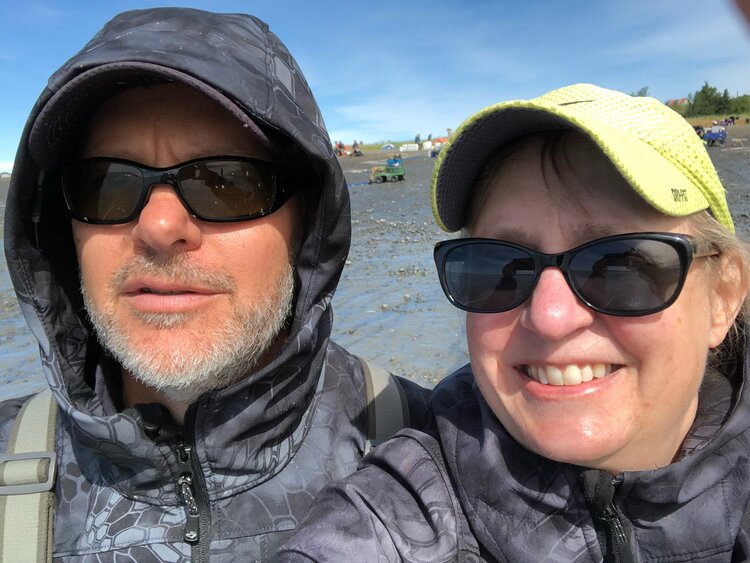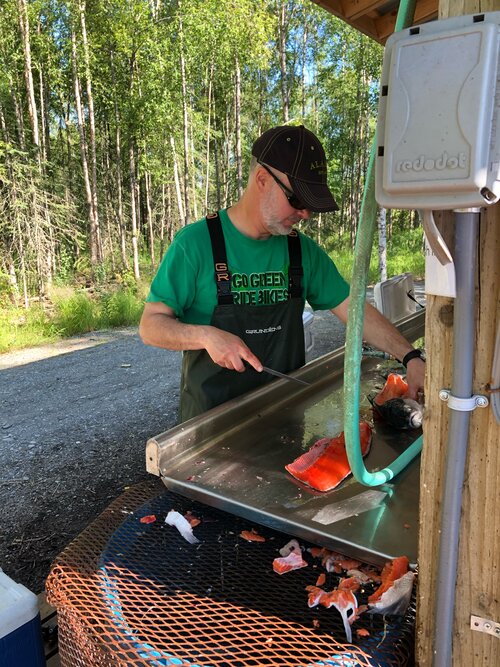Dipnetting 101
Summers in Alaska are crazy busy for most people because they are so short. Everyone tries to cram in as much as possible before the snow starts to fly again. Our family is no different. We’ve been camping, fishing and hiking almost every weekend. By the time winter gets here, we are exhausted and ready to sit by the fire drinking hot chocolate. But for now, we are playing hard and working hard.
One of the perks of being an Alaska resident is being allowed to “dipnet” for salmon. People stand out in the mouth of a river with a huge net and wait for fish to swim into it. Then you quickly flop the net over to one side and drag it up on the beach. You then “bonk” or hit the fish on the head to kill it instantly, cut the gills to bleed it and clip the tail fin to meet the state regulations to indicate you’ve caught that fish dipnetting instead of sport fishing (using a rod and reel). After that, you toss the fish in a cooler and get back in the water to try to catch another one.
This sounds like a simple procedure, but it’s a lot of work. The nets are big (mine is five feet in diameter) and the handles are long. Some people have extensions making their poles even longer in order to get the net into deeper water. They are heavy and hard to maneuver. If the current is strong, it can be difficult to keep your net in the right place and not let it swing into your neighbor’s net. And it’s usually very crowded with people standing in a line right next to each other.
To keep from getting wet people wear chest waders and rubber gloves that go up past your shoulders. You stand in as deep water as you can without waves splashing you. Paying attention to the waves is important because sometimes a larger one will sneak up on you and pour water right down into your waders. Don’t ask me how I know. And that water is COLD! Just standing there for hours in approximately 50 degree water will chill you to the bone. We wear tons of layers under our waders. I always feel like Randy in the movie A Christmas Story… “I can’t put my arms down!”
When a fish bumps your net, the trick is to quickly tip your net to one side so that the fish gets trapped underneath. Knowing which way to tip it can be tricky because you never know exactly what direction the fish is swimming. I generally try to tip into the direction of the current depending on if the tide is coming in or going out. But this doesn’t always work because the fish can swim whatever direction they want to. For me, it all happens so fast that it’s usually just a reaction and I can’t even remember what direction I tipped it. I’m usually not paying attention when a fish bumps because it can get boring just standing there. If there’s a lot of fish coming in then it’s a lot more fun but this year, at least when we were there, fish were hard to come by. We stood for hours without catching anything and my mind definitely wanders in that instance.
So, standing in freezing cold water for hours waiting for a fish in your net doesn’t sound like fun, huh? Oh, but once you feel that bump, it’s so exciting. It’s like Christmas morning because you never know what you’re going to get. You may pull that net up on the beach and find nothing because the fish got out or it just hit the rim of the net. Or you may have caught a little flounder which is not what you’re after. A guy next to me this year actually caught a shark! That is NOT what you want. (Catching sharks is highly abnormal and they aren’t the kind that will hurt you. And if you’re wondering, I did continue to fish after this incident. 😂) The goal is to catch a Sockeye Salmon, or Red Salmon. These are such yummy fish and they smoke, can and freeze well.
Each Alaska family is allowed a certain number of fish each season. The head of household gets 25 and each additional family member is allowed 10. The total for our family this year is 55. After fishing for three days, we got 11 which is abysmal. Fishing was super slow when we were there, yet I have two friends who caught 45 in about 7 hours. You never know when a school will come in. You have to be at the right place at the right time.
Once you’re back home with your precious catch, it’s time to process fish. We generally freeze the fresh fish, but to make room in the freezer, we take out any fish left from the previous year and smoke and/or can them. It’s a long process. At this point I’m usually glad we didn’t catch as many as we wanted too. But come winter, oh that fish sure tastes good.
I hope you’ve enjoyed this brief explanation of dipnetting. If you want to try it, you must move up here and become a resident. But, if you just want to come visit, we will take you sport fishing instead which is even more fun in my opinion.
We’ve been camping, fishing and hiking almost every weekend. By the time winter gets here, we are exhausted and ready to sit by the fire drinking hot chocolate. But for now, we are playing hard and working hard.
– Judy Anne Parker
The Latest Blog Posts
Savory S’mores
Savory S'mores We had our first fire of the season in our backyard firepit. Woohoo! And there was great rejoicing in the land. One of the things we love about summer is making s'mores over a fire. Of course the old standby of chocolate, marshmallows, and graham...
Transformations
Transformations Every year at the Alaska State Snow Sculpting Championships artists transform 8’ by 8’ blocks of snow into amazing works of art. My friend Allison and her family compete in this incredible experience. They carefully plan their design, use specific...
God is Not Disappointed in You
God is Not Disappointed in You God uses the weirdest circumstances to teach me lessons. On this particular occasion He used a sea urchin and a bottle of vodka to help me realize He is not disappointed in me. And I have wonderful news for you. He is NOT disappointed in...















